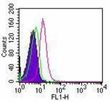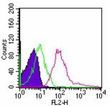TLR5 Mouse Monoclonal Antibody [Clone ID: 85B152.5]
Frequently bought together (2)
Transient overexpression lysate of toll-like receptor 5 (TLR5)
USD 605.00
Other products for "TLR5"
Specifications
| Product Data | |
| Clone Name | 85B152.5 |
| Applications | FC, WB |
| Recommended Dilution | Flow (Cell Surface), Immunohistochemistry-Paraffin, Flow (Intracellular), Immunohistochemistry, Flow Cytometry: 1-3 ug/10^6 cells in 100 ul, Western Blot: 1-3 ug/ml |
| Reactivities | Human, Mouse, Canine |
| Host | Mouse |
| Isotype | IgG2a |
| Clonality | Monoclonal |
| Immunogen | This antibody was developed against KLH-conjugated synthetic peptide corresponding to a portion of human TLR5. It will cross-react with mouse TLR5 (NP_003259). |
| Formulation | PBS containing 0.05% BSA, 0.05% Sodium Azide. Store at 4C short term. Aliquot and store at -20C long term. Avoid freeze-thaw cycles. |
| Concentration | lot specific |
| Purification | Protein G purified |
| Conjugation | Unconjugated |
| Storage | Store at -20°C as received. |
| Stability | Stable for 12 months from date of receipt. |
| Predicted Protein Size | 100 kDa |
| Gene Name | toll like receptor 5 |
| Database Link | |
| Background | The Toll-like receptor (TLR) family in mammal comprises a family of transmembrane proteins characterized by multiple copies of leucine rich repeats in the extracellular domain and IL-1 receptor motif in the cytoplasmic domain. Like its counterparts in Drosophila, TLRs signal through adaptor molecules and could constitute an important and unrecognized component of innate immunity in humans. The TLR family is a phylogenetically conserved mediator of innate immunity that is essential for microbial recognition. TLRs characterized so far activate the MyD88/interleukin-1 receptor-associated kinase (IRAK) signaling pathway. Thirteen homologs of TLRs (TLR1-13) have been described. Toll-like receptor 5 (TLR5) expression is upregulated following exposure to bacteria or to the TLR5 agonist, flagellin. Gram-negative bacteria, stimulate monocyte/macrophage cells in a TLR5-specific, CD14-independent manner. The TLR5 receptor thus appears to be the principal means by which the innate immune system recognizes flagellated bacterial pathogens. |
| Synonyms | MELIOS; SLE1; SLEB1; TIL3 |
| Note | Reported use in Flow Cytometry (cell surface): see Wong et al, 2007 for details. |
| Reference Data | |
| Protein Families | Druggable Genome, Transmembrane |
| Protein Pathways | Pathogenic Escherichia coli infection, Toll-like receptor signaling pathway |
Documents
| Product Manuals |
| FAQs |
| SDS |
{0} Product Review(s)
0 Product Review(s)
Submit review
Be the first one to submit a review
Product Citations
*Delivery time may vary from web posted schedule. Occasional delays may occur due to unforeseen
complexities in the preparation of your product. International customers may expect an additional 1-2 weeks
in shipping.






























































































































































































































































 Germany
Germany
 Japan
Japan
 United Kingdom
United Kingdom
 China
China







